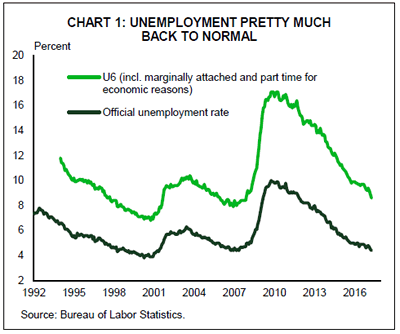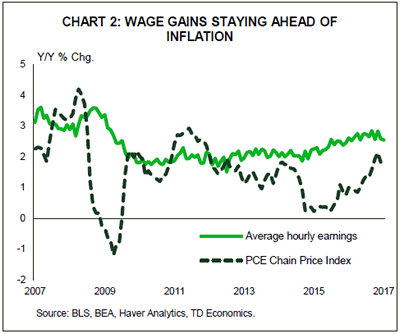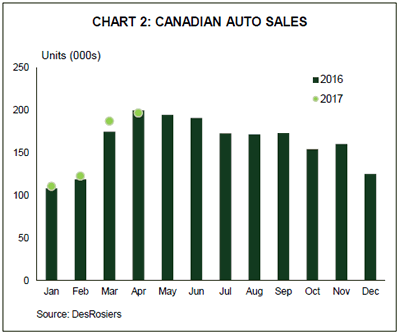HIGHLIGHTS OF THE WEEK
United States
- The past week was action packed with economic data and events in Washington. Data largely supported the view that the U.S. economy will bounce back from its winter weakness.
- The job market sprang back into action in April, enabling investors to heave a sigh of relief that the fundamentals remain in place for a Q2 rebound. The Fed expressed its confidence in the economy in its statement accompanying its stand pat rate decision.
- Still, weak auto sales and a recent loss in inflation momentum suggest the U.S. economy is not entirely out of the woods. The Fed will be watching the data closely in the coming weeks before the case for a June hike is cemented.
Canada
- An 8% drop in crude oil prices led the S&P/TSX to a 6-week low and took the loonie below 73 US cents for the first time in over a year.
- The Canadian economy added just 3k jobs in April. The unemployment rate fell to 6.5% as 45k people left the workforce. Wage growth slowed to a record low of just 0.5% y/y.
- Auto sales slipped 1.6% y/y in April, but this follows a record breaking quarter. Sales remain quite elevated relative to historical norms.
- Exports bounced back in March, helping to narrow Canada’s trade deficit. However, net trade will still be a drag on growth during the first quarter.

UNITED STATES – ECONOMY SHOWING SIGNS OF SPRING THAW
From Washington to Wall street, there was no shortage of news for investors to digest this week. Data largely supported the view that the U.S. economy is bouncing back from its winter weakness. Markets have one eye turned on policy shifts in Washington too, where the GOP took baby steps towards repealing and replacing Obamacare (ACA). The revised American Health Care Act (AHCA) passed the House by a very narrow margin, but faces a bigger challenge in the Senate.
Investors heaved a sigh of relief on Friday as the job market bounced back in April, bearing out the Fed’s confidence in the economy expressed in Wednesday’s rate announcement. Payrolls advanced 211k jobs in April and the unemployment rate fell to 4.4% – the lowest level since 2007. Broader measures of labor market slack also declined, with the broadest U6 measure (including discouraged workers and involuntary part-timers) falling to 8.6%, just 0.2 percentage points off its pre-recession level (Chart 1). Average hourly earnings rose 0.3%, as expected in April. That left wages up 2.5% over a year ago, not yet flashing red, but is still sufficient to provide real gains in purchasing power (Chart 2). This should flow through to consumer spending in the months ahead, providing the impetus for stronger economic growth.
As expected, the Fed kept interest rates unchanged on Wednesday and issued a largely status quo statement. It pointed to continued improvement in the labor market, while seeing through disappointing economic growth in the first quarter. The weakness in inflation in March was noted, but one-month’s result is unlikely to sway the Fed. As Yellen has continually emphasized, the Fed’s path is data dependent. So, members will be watching the data closely over the next few weeks as indicators for the second quarter are released. If the numbers confirm that a second quarter rebound is underway, and that the slowdown in inflation has not become more entrenched, we would expect the Fed to take rates higher in June.
So far this year, measures of sentiment have been more ebullient than the "hard" economic data. Not surprisingly, the ISM Manufacturing index did lose of bit of its postelection optimism in April. We have raised concerns that markets might have been a bit overconfident that Washington could easily implement highly stimulative fiscal policy. While this week, the House finally passed a bill to repeal and replace the ACA, this is only the first step in an ongoing process. Passage in the Senate where the Republican majority is even slimmer, will prove much more difficult.
Passing healthcare reform into law is arguably a necessary pre-condition to making further changes to the tax code. This is because the savings achieved leave room to cut taxes without expanding the deficit. The Congressional Budget Office has not yet scored the new bill, but the previous bill reduced the deficit by over $330 billion over the next decade. This is only about one-tenth of what is necessary to pay for Trump’s proposed tax cuts, but it might allow for some reduction in the corporate tax rate. In any case, there is a long road ahead on forging consensus on both the AHCA and eventually tax reform, leaving the potential for further sentiment disappointments in the months ahead.


CANADA – PLUNGING OIL PRICES WEIGH ON FINANCIAL MARKETS
It was a rough week for Canadian financial markets, as the S&P/TSX index and the Canadian dollar were pulled down by an 8% plunge in crude oil prices to US$45 per barrel. The equity market hit a 6-week low, while the loonie fell below 73 US cents for the first time in over a year.
Oil prices have now fallen by 15% in just three weeks, reaching the lowest level seen since November 2016 – right before OPEC members agreed on production cuts. The drop stemmed from concerns surrounding the global supply glut, as efforts by OPEC and a group of non-OPEC countries to scale back production have yet to put a meaningful dent in global stocks. Meanwhile, production elsewhere – particularly in the U.S. – has been on the rise. Indeed, U.S. oil production continues to expand, now sitting at 9.3 million barrels per day – a level not seen August 2015. OPEC will meet on May 25th to determine whether production quotas will be extended past June. Indications from the cartel suggest that they will, however, it appears as though markets are starting to think that bigger cuts will be necessary to bring the market back into balance. Volatility in oil prices is likely to continue as the meeting approaches, moving in response to rhetoric coming from OPEC and U.S. production and inventory data.
On the economic front, data out this week was mixed. The Canadian economy added just 3k jobs in April, all part-time, and wage growth slowed to 0.5% y/y – half of its first-quarter pace and the slowest pace on record. While a disappointing report, it does follow several months of strong job creation.
Auto sales were down 1.6% versus year-ago levels, but the drop comes on the heels of a record-breaking first quarter and is contending with last year’s stellar performance when sales topped 200,000 units for the first time in a single month. Needless to say, even with a slight pullback in April, auto sales remain quite elevated. That said, given the remarkable strength seen in recent years, it would not be surprising to see auto sales lose some steam in the coming months.
International trade data showed a bounce back in export volumes in March, while imports edged down slightly. This won’t be enough to prevent net trade from weighing on economic growth during the first quarter – thanks to rebounding imports – but it does provide a solid hand off for Q2. Moreover, momentum in exports should continue going forward, as the Canadian dollar remains under pressure and economic activity in the U.S. is set to pick up after a slow start to the year.
This will help underpin the rotation in Canadian growth drivers away from stretched consumers and housing, toward a more balanced growth path. In a report released this week, we noted that stabilization in non-residential investment and a modest improvement in other business investment, combined with a better net trade performance should offset expected declines in housing activity over the remainder of this year, keeping the economy advancing at a decent clip of just under 2%. The Bank of Canada will be looking for such signs of a more sustainable growth path before moving off the sidelines.














